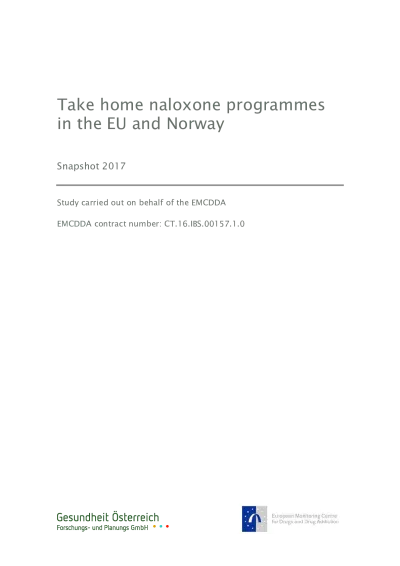Summary
People who overdose on opioids generally receive naloxone, a life-saving overdose reversal drug. This treatment has been used by emergency medicine in ambulance as well as hospital settings since the 1970s to reverse the respiratory depression caused by the overdosed opioid. In 1998 the first European take-home naloxone project was initiated in Berlin/ Germany, making the antidote available in places where overdoses are likely to occur. This harm reduction intervention combines a provision of the emergency supply of naloxone to those people who are likely to witness an opioid overdose and have a specific training in overdose emergency, after-care management as well as instructions about its administration. Since then various THN programmes/ projects were implemented in the EU and Norway with a current increase of new and recently planned initiatives.
The following report gives an overview of the characteristics of the current state of available THN programmes/ projects in the EU and Norway in 2016/2017. It aims at updating and specifying the THN projects presented in the EMCDDA Insights 20 (Strang & McDonald 2016). It specifically focuses on the description of details on the legal/ regulatory aspects and input and how to tackle them, regarding the modes of THN initiatives as well as their performance and cost needs. A collection of links to training material and of some recent scientific papers is also available.
To collect the information presented in this report, a specific template has been developed in cooperation with the EMCDDA. The template contains overall questions on the THN projects and specifies on existing challenges of its implementation: type of medication and application, legal status. Further it includes questions on training components, naloxone distribution, re-fill procedures as well as on the performance and estimated resources. The templates were pre-filled with available information for each THN initiative and sent out to the national experts identified through the EMCDDA Head of Focal Points. In total 16 templates from ten EU countries have been returned.
Chapter 2 gives a historical overview of the THN programme development and update core data from current programmes in the EU and Norway. It further presents ten country profiles, including background materials and links to project reports and training materials. THN programmes/ projects are currently available in Denmark, Estonia, France, Germany (5 Projects), Ireland, Italy, Lithuania, Norway, Spain/ Catalonia, the UK, UK/ Scotland and UK/ Wales. The geographical spread varies from national to regional up to local initiatives, ranging from a total of less than 100 THN-kits distributed up to nearly 30.000 THN-kits.
Chapter 3 gives an overview of the main aspects of THN programme designs, describing types of medication and application and distribution and re-fill procedures. Aspects of the contextual framework and cooperation with partners and costs and funding are outlined. At present the majority of THN initiatives provide injectable naloxone products, some by providing or recom-mending an off-licence application tool. Currently only France and Denmark dispense a licenced nasal spray. It is expected that the ongoing process of introducing nasal formulation of naloxone in the EU might change this currently predominant application form. Most of the THN initiatives are targeting at and training current or former drug users in drug services, with an emphasis on the low threshold setting. Six THN projects are based in prison or upon release from prison. Peer involvement is an essential part in the majority of the initiatives; apart from recruitment they are involved in programme development as well as in trainings.
This Chapter 3 focuses on the description of THN programme approaches to deal with specific legal and regulatory challenges. Practice has shown that the major challenges to THN pro-grammes/ project rise from legal/ regulatory aspects, due to the fact that naloxone is a prescription only medication (POM) in most of the countries. The report outlines concepts and strategies to tackle these challenges with regard to the prescription of naloxone to non-medically qualified third parties, the distribution of naloxone to third parties and its administra-tion by a not medically qualified person/ layperson in case of a drug emergency.
Chapter 5 summarises the main aspects regarding THN trainings, which generally are a relevant component of THN initiatives. In seven interventions the THN training is part of a general overdose-management training. THN trainings generally often involve physicians or nurses/ paramedics as trainers. Apart from drug users, family/ partners/ close friends are a target group often addressed at THN trainings, followed by outreach workers and staff members at drug agencies.
Chapter 6 refers to a possible framework for monitoring THN programmes/ projects.
Download as PDF
PDF files are made available as a convenience. In cases where the EMCDDA is not the originator of the document, please be aware that any PDFs available on this page may not be authoritative or there may be more recent versions available. While we make every effort to ensure that these files are definitive, before using or citing them, we recommend that you consult the publisher's website or contact the author(s) to check for more recent versions.
Additional information
This study was commissioned by the European Monitoring Centre for Drugs and Drug Addiction (EMCDDA contract CT.16.IBS.0157.1.0) to promote the dissemination of good implementation practices in the field of overdose prevention.









